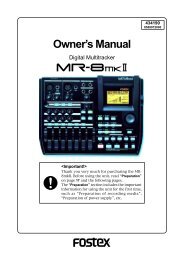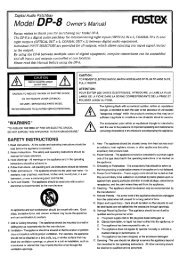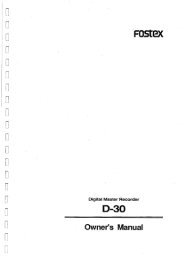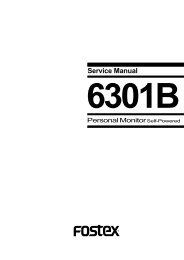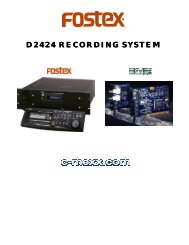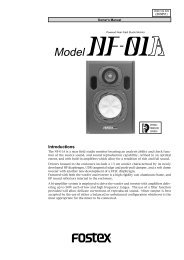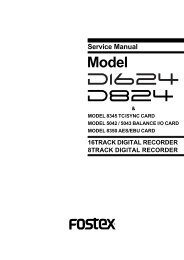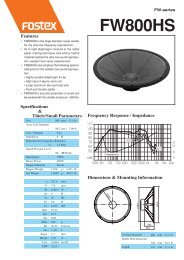audio file in the INSERT mode - Fostex
audio file in the INSERT mode - Fostex
audio file in the INSERT mode - Fostex
Create successful ePaper yourself
Turn your PDF publications into a flip-book with our unique Google optimized e-Paper software.
You can create an <strong>audio</strong> <strong>file</strong> before record<strong>in</strong>g.<br />
As expla<strong>in</strong>ed earlier, when mak<strong>in</strong>g record<strong>in</strong>g <strong>in</strong> <strong>the</strong> NEW FILE <strong>mode</strong>, a new <strong>audio</strong> <strong>file</strong> is created on <strong>the</strong><br />
disk. Therefore, each time you make record<strong>in</strong>g <strong>in</strong> <strong>the</strong> NEW FILE <strong>mode</strong>, <strong>the</strong> number of <strong>audio</strong> <strong>file</strong>s <strong>in</strong>creases<br />
by one. However, you can create a new <strong>audio</strong> <strong>file</strong> before mak<strong>in</strong>g record<strong>in</strong>g regardless of whe<strong>the</strong>r<br />
"No Audio Files!" is shown or any <strong>audio</strong> <strong>file</strong> is already created. Note that you can only make record<strong>in</strong>g to<br />
<strong>the</strong> exist<strong>in</strong>g <strong>file</strong> <strong>in</strong> <strong>the</strong> <strong>INSERT</strong> <strong>mode</strong> described later.<br />
To create an <strong>audio</strong> <strong>file</strong>s before mak<strong>in</strong>g record<strong>in</strong>g, follow <strong>the</strong> procedure below.<br />
1. Set <strong>the</strong> [AUDIO FILE], [TR MODE] and [SAMPLING FREQ] switches to <strong>the</strong> desired positions.<br />
<br />
A new <strong>file</strong> will be created with <strong>the</strong> appropriate <strong>audio</strong> <strong>file</strong> format, track <strong>mode</strong> and sampl<strong>in</strong>g frequency/bit<br />
length comb<strong>in</strong>ation accord<strong>in</strong>g to <strong>the</strong> switch sett<strong>in</strong>gs.<br />
2. Press <strong>the</strong> [FILE SEL] key.<br />
• When "No Audio Files!" is shown (i.e. <strong>the</strong>re is no <strong>audio</strong> <strong>file</strong> on <strong>the</strong> disk), press<strong>in</strong>g <strong>the</strong> key br<strong>in</strong>gs up<br />
"New File?" with flash<strong>in</strong>g "01" on <strong>the</strong> display.<br />
Flash<strong>in</strong>g<br />
ABS<br />
H M S F<br />
PGM<br />
• If any <strong>audio</strong> <strong>file</strong> exists, <strong>the</strong> <strong>audio</strong> <strong>file</strong> number currently selected starts flash<strong>in</strong>g.<br />
By rotat<strong>in</strong>g <strong>the</strong> jog dial <strong>in</strong> this condition, you can br<strong>in</strong>g up "New File?" with flash<strong>in</strong>g "**" on <strong>the</strong> display<br />
(where "**" is one greater than <strong>the</strong> number of <strong>the</strong> exist<strong>in</strong>g <strong>audio</strong> <strong>file</strong>s).<br />
In <strong>the</strong> display examples on <strong>the</strong> right, <strong>the</strong> number "01" <strong>file</strong> is selected. The new <strong>file</strong> number is "03".<br />
because two <strong>audio</strong> <strong>file</strong>s exist on <strong>the</strong> disk.<br />
ABS<br />
H M S F<br />
PGM<br />
PGM<br />
NEXT<br />
Flash<strong>in</strong>g<br />
Flash<strong>in</strong>g<br />
3. Press <strong>the</strong> [ENTER/YES] key.<br />
A new <strong>file</strong> is created and selected. The display shows <strong>the</strong> tentative title of <strong>the</strong> newly created <strong>file</strong> with<br />
"ABS 0" time. You can make record<strong>in</strong>g <strong>in</strong> <strong>the</strong> <strong>INSERT</strong> <strong>mode</strong> to an <strong>audio</strong> <strong>file</strong> created before record<strong>in</strong>g.<br />
You can also give a desired <strong>file</strong> title to <strong>the</strong> created <strong>file</strong>, or delete unnecessary <strong>file</strong>s.<br />
See "Chapter 9: Operations with <strong>audio</strong> <strong>file</strong>s" for details.<br />
<br />
If you create a new <strong>audio</strong> <strong>file</strong> when one or more <strong>audio</strong> <strong>file</strong>s are available, <strong>the</strong> <strong>file</strong> number is counted <strong>in</strong>dependently<br />
by "BWF" and "SDII" <strong>file</strong>s. For example, if you create an "SDII" <strong>file</strong> to a disk on which three "BWF" <strong>audio</strong><br />
<strong>file</strong>s are available, <strong>the</strong> <strong>file</strong> number of <strong>the</strong> created "SDII" <strong>file</strong> is "01".<br />
Therefore, when select<strong>in</strong>g a desired <strong>audio</strong> <strong>file</strong> from among more than one <strong>file</strong>, you must set <strong>the</strong> [AUDIO FILE]<br />
switch appropriately. See "Tips" on page 4-9 for details.<br />
4-7



